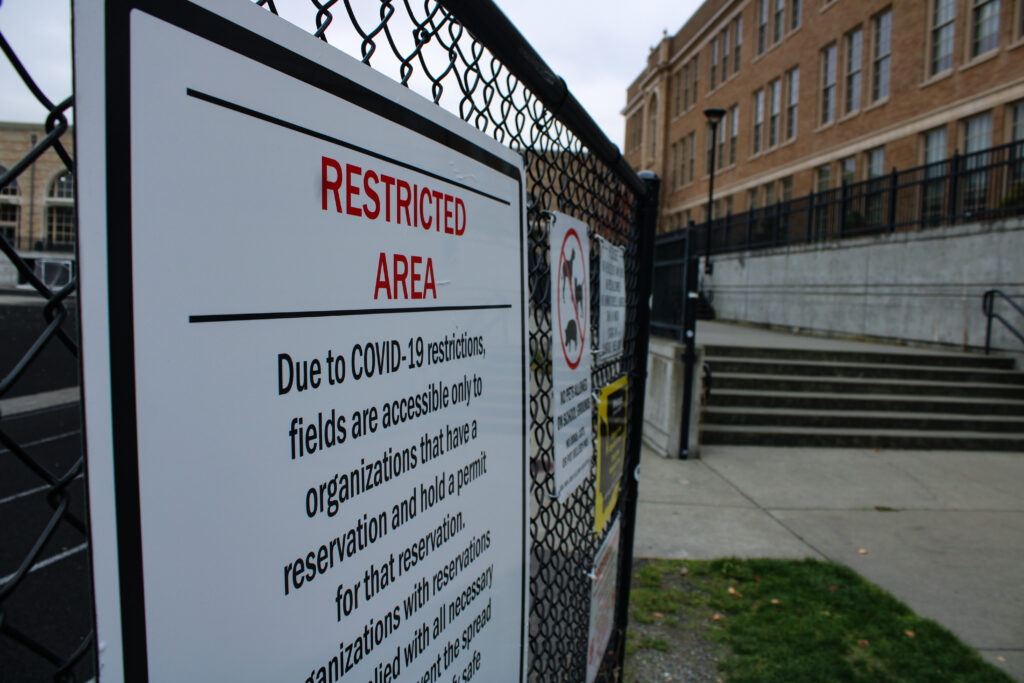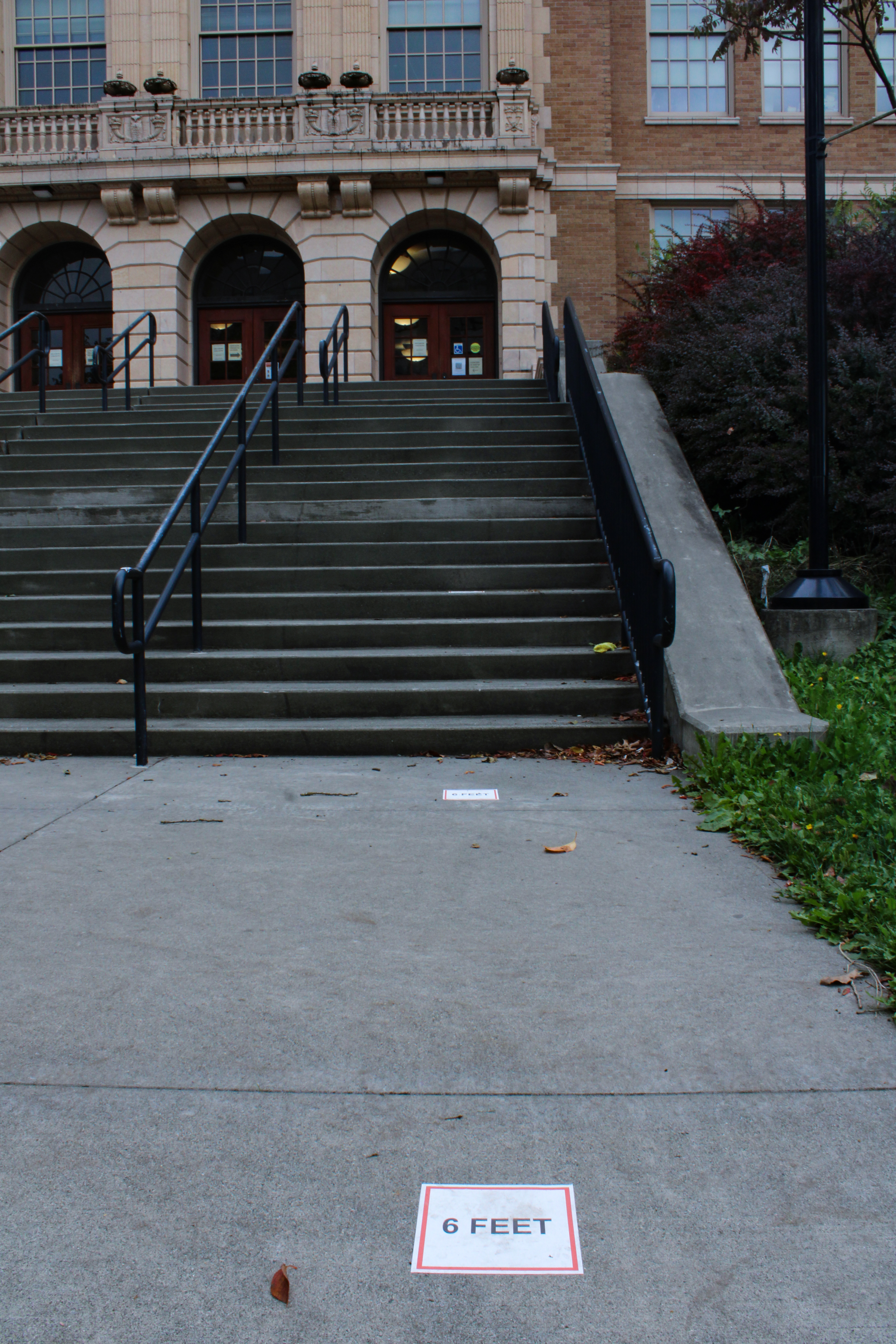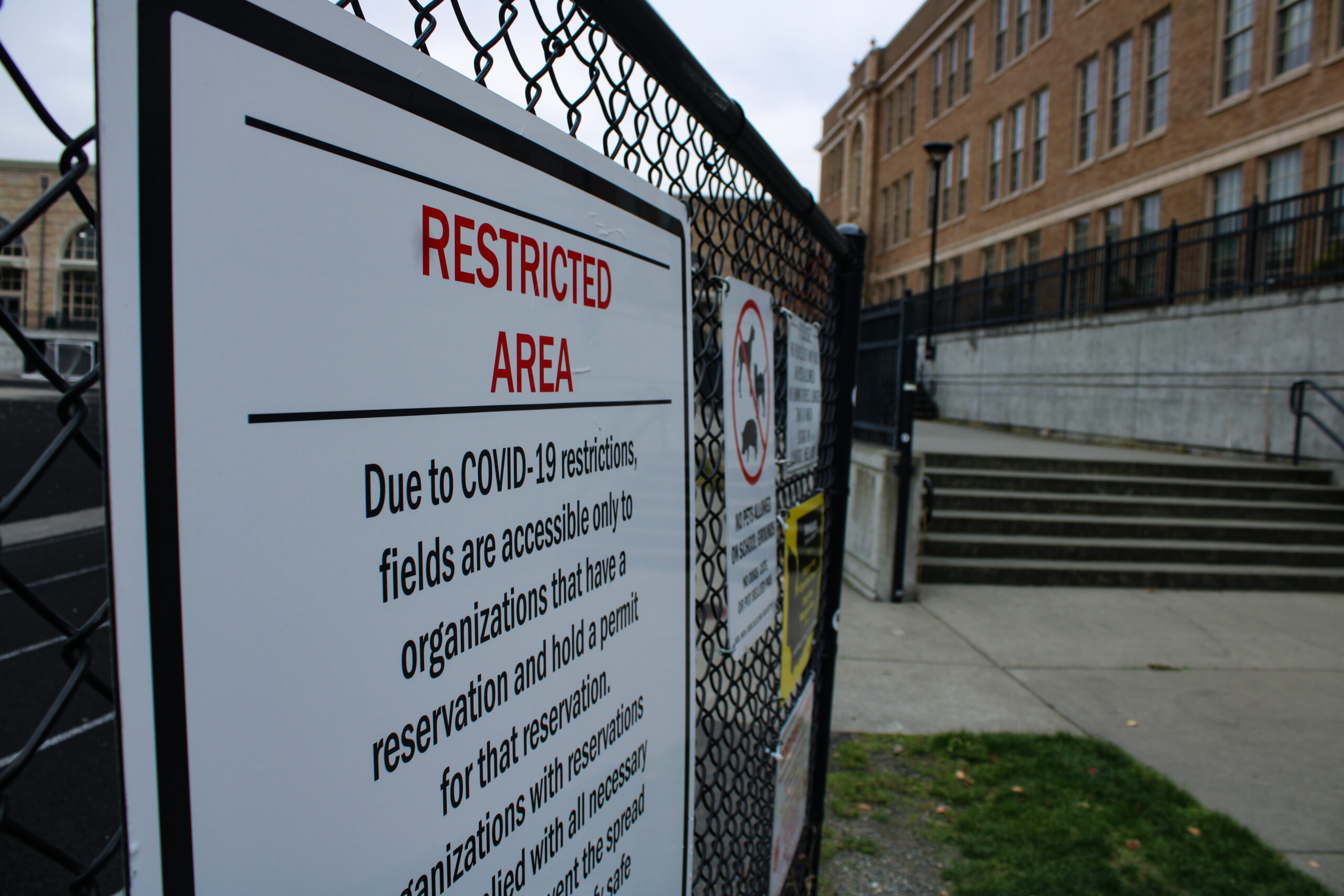
On the border of Washington and Idaho, high school seniors Rachel Meeuwsen, Garret Blomgren, and Paige Collier return to school for the first time since March.
From the outside, the school looks emptier than previous years. During a normal school year, students would congregate in the student parking lot and hallways in anticipation of the school bell’s ring.
But this year, they are ordered straight to class.
When they get to the building, obscured faces wait for temperature guns and a masked teacher conducting health screenings to permit them to continue.
Yet behind the masks, there is an undeniable sense of positivity in the building as students and teachers reunite. It is difficult not to get to know everyone. With a school enrollment of 86 and a graduating class of 25, the class of 2021 is already well acquainted with their teachers and peers.
Once students take their seats and the bell rings, teachers welcome them back and take attendance as they did in years past. While school looks different this year, the students say that it still feels the same; seniors say they are grateful for the sense of normalcy and a chance to see their peers before graduation.
Like many rural towns across the United States, Garfield-Palouse School District in Whitman County reopened its doors to elementary students in September, and now is beginning in-person learning for middle and high school.
Despite seemingly low numbers, Whitman County currently has the highest COVID-19 infection rate per capita in Washington state. The county has had over 400 newly diagnosed cases per 100,000 residents over the past two weeks, largely attributed to the return of college students at Washington State University. According to the Washington State Department of Health, the county’s case numbers exploded in late August, tripling within the week of students returning to campus.
“We are currently a high (case) county, but the epicenter seems to be Pullman,” said Mike Jones, Principal of Garfield-Palouse High School and Palouse Elementary School. “So they’ve [The Whitman County Department of Health] given the green light for outlying communities.”
While considering that many families work in Pullman and Moscow, Jones said that the district also considered the academic, social, and emotional needs of students. “We broke it down and looked at our communities specifically, looked at what our community wanted, and looked at what the impact on the community was going to be, what the levels are in our own communities, and went that way.”
Conversely, the largest county in Washington, King County, has maintained under 100 cases per 100,000 since early August, while local school districts have remained shuttered.

Large school districts across the nation, from Orange County to New York, have begun announcing reopening plans or have even resumed in-person learning in favor of part or full-time models. So where is Seattle in this conversation?
Closer to home, neighboring districts have announced reopening schedules, though many have not gone according to plan.
The Tacoma School District was forced to delay the return of students in late September after the Department of Labor deemed the district’s N95 masks provided to educators inadequate. Within weeks, Tacoma was forced to pause its reopening plans indefinitely after a surge of COVID cases in Pierce County.
On October 7th, Bellevue became the largest King County school district to announce the reopening of school buildings. Within a week, Bellevue too was forced to postpone in-person learning until January as a result of increased COVID cases.
In contrast to our neighbors, Seattle Public Schools has remained relatively silent on its plans to reopen since its proposed hybrid model was abandoned in late July following the summer’s COVID surge, leaving many parents feeling left in the dark.
“I’ve had to be much more proactive to get answers,” said Brenna Pink Pampena, mother of 3rd grader Cadance Pampena, who attends Bailey Gatzert Elementary, and sophomore Rocco Pampena, who attends Garfield High School. “Its [communication] has been pretty sparse. I got an email saying they were putting together a task force. From then, I don’t really know what Seattle’s plans are.”
She said that the district needs to communicate their plans more regularly and concisely with families, citing the specific need for more clarity around school expectations across the district.
While Pampena remains cautious, like many parents, she worries how her kids will catch up once they return to school. “I don’t know if the way that the schools are set up, that they have the ability to be creative enough to get kids ahead,” she said. “I know that teachers are working really hard, but I think the system really isn’t built to be creative and dynamic enough for what they need […] It’s going to require a lot of parent support, which is hard, because not all kids have it.”
Teachers across the district are also feeling the strains of the district’s communication.
“I think we just could have used a little more support in best practices in how to reach out to students,” said Jordana Hoyt, Roosevelt High School teacher and union representative. “The district certainly tried in some ways to address that, but I think they could have more continued training about remote learning in particular […] I feel like most of my remote learning stuff has been self-taught, with my colleagues collaboratively.”
While communication is one of the many challenges Seattle faces, another is determining when it is safe to reopen.
Overall, Washington state’s reopening guidelines are stricter than most other states.
Nationally, Washington has instituted some of the earliest precautions allowing the once U.S. epicenter to fall down the charts in cases. According to recent data released by the Seattle Times, Seattle may even have the lowest rate per capita of COVID infections of all major U.S. cities (as of October 5th).
The Washington State Department of Health currently recommends districts begin to consider reopening elementary schools once the county has reached roughly 5 daily cases per 100,000 residents and less than two cases for secondary schooling.
Several states, such as Connecticut, follow models more similar to the Harvard Global Health Institute, recommending grades k-8 begin to reopen once there are 10-25 daily cases, meaning Washington state’s recommendations are between two and five times as stringent.
In the late summer agreement between the Seattle Education Association (Seattle teachers’ union) and Seattle Public Schools, the district settled to follow the Washington State Department of Health and OSPI Decision Tree for K-12 guidelines during the 2020-2021 school year. This ensures that Seattle will not move forward with in-person schooling until within the state’s guidance of safety.
“I think the teachers’ union has done a great job at defending the health of teachers and students,” Hoyt says. “…certainly, the district is also being careful, but the union is what’s going to hold the district to that high standard of making sure that we are ready to reenter the building… they will ensure that students and teachers are safe and actually upholding safety protocols before we can return.”
On October 23rd, Seattle Public Schools announced that the district would remain remote through at least January 28th as a result of increased COVID cases.
In accordance with state issued recommendations, once King County has consistently maintained a maximum of 75 cases per 100,000 over a two-week period, Seattle will prioritize the reopening of schools to elementary students and those receiving special education services. Only once 25 cases have been met will middle and high schools will be permitted to reopen through a hybrid model.
Proponents claim that hybrid models reduce virus transmission as a result of limited school contacts in groups known as “cohorts” or “pods,” and help track and contain outbreaks.
Others worry that hybrid models could be worse than full-time in-person learning, referencing younger students extending their contacts through part-time child-care and older students spending more time with friends outside of school.
For the foreseeable future, we will not be returning to school. If and when we go back, our days will look drastically different from the minute we wake up.
Roosevelt will almost certainly reopen under a hybrid model, in which classes will alternate daily or weekly, and are limited to 2-4 per day in conjunction with asynchronous learning in order to keep students in cohorts.
Aside from masks, once on school premises, students, staff, and other personnel must undergo screening including questionnaires, daily temperature checks, and maintaining social distancing guidelines.
Required on-site measures will include adequate ventilation and HVAC systems, routine cleaning, protective gear for onsite personnel, transportation plans, and plans for monitoring, tracking, and isolating COVID cases within Roosevelt.
School districts are in a difficult position where no side of the argument comes without losses. “Districts are facing challenges unique to themselves,” Jones says. “…I think that the state is in a very difficult position in that way. There is no one size fits all model.”
One thing we know for sure is that online learning is here to stay and will change the course of learning forever.
“As a teacher, I have really thought about how I could reform my practice, this might lead to a lot of educational reform,” said Hoyt. “It has certainly gotten me to think about what is most important in my curriculum, which is kind of a nice thing to think about. How it is that we really highlight what we think will be most engaging to students, what is most important to skill development, and that this is a time for them to learn how to be an independent learner.”
When we will return to our classrooms to play Kahoot, attend the occasional pep assemblies, or stress-study in the cafeteria on a Friday morning remains a waiting game.
For now, we will have to rely on the “Reopening Task Force,” Google, and our teachers to guide our learning.
